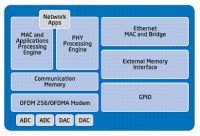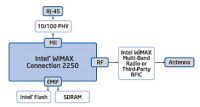Intel WiMAX 调制解调器解决方案
2008-01-18
作者:Intel
Intel® WiMAX Connection 2250是下一代WiMAX片上系统" title="片上系统">片上系统(SoC),除了支持固定WiMAX网络标准" title="网络标准">网络标准 IEEE 802.16-2004 (也称作802.16d),还支持移动WiMAX网络标准IEEE 802.16e-2005 (也称作802.16e),是业界首个双模式基带芯片" title="基带芯片">基带芯片,和Intel的三频段" title="三频段">三频段WiMAX无线电收发芯片" title="收发芯片">收发芯片以起,解决方案支持全球的WiMAX频率。 WiMAX Connection 2250还和Intel® PRO/Wireless 5116 modem引脚兼容,很容易通过软件便能从 IEEE 802.16-2004升级到IEEE 802.16e-2005。本文介绍了WiMAX Connection 2250的主要性能,CPE 系统方框图和 WiMAX解决方案。
The Intel® WiMAX Connection 2250 is an integrated WiMAX system on chip (SoC) that is optimized for cost-effective WiMAX modems and offers flexibility in equipment design, deployment, and application.
The Intel WiMAX Connection 2250 is compliant with both IEEE 802.16-2004 and IEEE 802.16e-2005 specifications. The dual-specification support is enabled by a software-configurable modem that operates as an OFDM 256 PHY (for IEEE-802.16- 2004 mode) or an OFDMA PHY (for IEEE 802.16e-2005 mode).
This unique feature enables development of customer premise equipment (CPE) that can be deployed in “d” mode and upgraded to “e” mode—enabling unmatched versatility, time to market, and investment protection.
Versatility and investment protection is further enhanced by the Intel WiMAX Connection 2250 processors backward compatibility with the Intel® PRO/Wireless 5116 broadband interface. The Intel WiMAX Connection 2250 uses the same package and pin layout— and supports a firmware/software load that provides the same functionality as the Intel PRO/Wireless 5116 broadband interface.
This architecture allows existing WiMAX-certified designs based on the Intel PRO/Wireless 5116 broadband interface to be quickly modified to host existing “d” mode implementations while also providing “e” mode upgrade capability.
When combined with the Intel® WiMAX Multi-Band Radio or thirdparty RFICs, the Intel WiMAX Connection 2250 enables manufacturers to create a broad range of WiMAX modems and residential gateways. These self-installed products are well-suited to both indoor and outdoor applications and provide support for channel bandwidths up to 10 MHz. The wide range of applications and regulatory domains provides an essential foundation for delivering high-rate, IP-based data, voice, and real-time video.
Two integrated ARM* 946E-S processors provide processing power that allows management and other layer-three networking applications to run on-chip, without need for an external applications processor. An integrated IEEE 802.3 Fast Ethernet Controller and security accelerator contribute to high performance at low cost. To further reduce cost, Intel WiMAX Connection 2250 hardware implementations are expected to be available through several third-party ODMs.
Included with the Intel WiMAX Connection 2250 are software development kits (SDKs) for both IEEE 802.16-2004 and IEEE 802.16e-2005 modes, providing developers with the necessary tools to harness the devices programmability.
图1: Intel® WiMAX Connection 2250 高级方框图
主要特性/亮点:
Modem (802.16-2004 Mode)
OFDM 256 PHY mode with support for channel bandwidths up to 10 MHz
TDD and H/FDD duplexing modes
Concatenated Reed-Solomon and Convolutional Encoding Forward Error Correction
Adaptive modulation (BPSK, QPSK, QAM16, QAM64)
Enhanced link budget support
Receive space time coding
Uplink sub-channelization
SNR, RSSI channel quality measurements
Switched diversity
ARQ
Modem (802.16e-2005 Mode)
OFDMA 512/1024 PHY mode with support for channel bandwidths up to 10 MHz
Support for TDD and H/FDD duplexing modes
PUSC with all subchannels and dedicated pilots, FUSC, AMC 2x3 for AAS Beam Forming support
Concatenated Reed-Solomon and Convolutional Encoding Forward Error Correction
Adaptive modulation (BPSK, QPSK, QAM16, QAM64)
Enhanced link budget support
2-channel matrix A MIMO support
Uplink/Downlink sub-channelization
SNR, RSSI channel quality measurements
Switched diversity
ARQ, HARQ
AAS/Beam Forming
MAC (802.16e-2005 Mode)
Payload Header Suppression
IPv4, IPv6, 802.3 Convergence Sub-Layers
ARQ, HARQ
UGS, RT-VR, NRT-VR, ERT-VR, and BE QoS classes
Sleep and Idle mode power management support
802.16 Authorization Policy and EAP Authorization Processing
Dual-core ARM* 946E-S engines for PHY, MAC, and application protocol processing
Highly optimized DSP engine with multiple parallel ALUs for concurrent complex operations per cycle, which enables efficient OFDM/OFDMA processing
In-line security processing using advanced encryption techniques (3DES, AES, and RC4) I/O and Interfaces
Modular RF interface supporting I/F or baseband I/Q radios designed for WiMAX licensed and unlicensed spectrum
Integrated pair of ADCs and DACs and a high-performance PLL to drive converters
Integrated 10/100 Ethernet MAC with MII interface to external PHY
SPI and memory interfaces for VoIP SoC Integration
Additional I/O and system interfaces
Extended memory interfaces—SDRAM and flash
Test and debug interfaces
Programmable GPIOs
Packaging and Thermals
360-pin industrial-grade PBGA supporting temperatures ranging from -40° C to 85° C
图2。Intel® WiMAX Connection 2250 CPE 系统方框图
图3。 WiMAX解决方案




